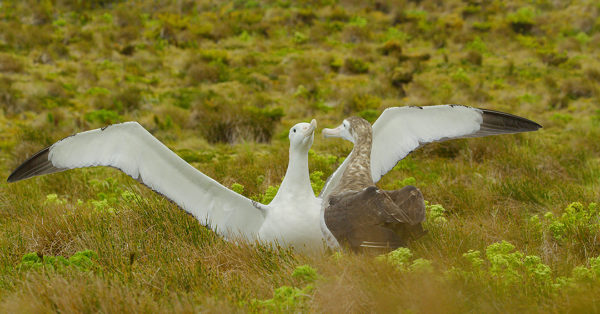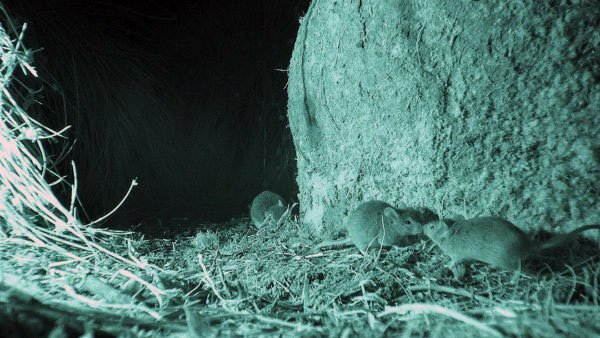Visiting the home of the Tristan Albatross
Report by Jonathon Hall on 30th January 2017

Male Tristan albatross courtship display on Gough Island. Photo by Brian Canavan
For years I’ve dreamed of visiting “Gonydale.” It’s a remote upland valley reached after a three-hour trek across rivers, beneath towering pinnacle cliffs and through thick lush ferns. It is a lost world, and one of the most magical and innocent places I’ve ever been. For it is here in this upland refuge that some of the last of the Tristan albatross (Diomedea dabbenena) breed. These giant and critically endangered birds are the ultimate ocean wanderers, travelling up to 1,000 km (620 miles) per day across the seas, yet up here in their secluded home they are being driven to extinction by the unlikeliest of predators—the largest house mice on the planet.
As we eventually reached the lip of Gonydale, our feet tired from tiptoeing around seemingly endless burrows of great shearwaters and other seabirds in the middle of the path, the vista opened up. It revealed the exhilarating sight of 40-50 of these enormous birds dotted around the valley floor and up its steep sides, their brilliant white breasts standing out clearly against the brown and yellow vegetation. With 3.5-m (11.5-ft) wingspans, they also wheeled above us like benign pterodactyls, the wind whistling off their wings as if a plane was flying low overhead. It’s courtship time, and the males were spreading their enormous wings, throwing their heads back, beaks to the sky, and emitting an incredible array of noises, from the gurgles of a percolating coffee machine to clicking and popping, which got our camerawoman running for her sound recording kit.
Totally unimpressed by human interlopers in their valley home, we were able to approach close and sit right by them as they tapped their enormous light-pink bills against each other and stared at us with their big black eyes. This naïveté to potential threats is the Achilles heel of these huge seabirds, as they simply don’t recognize land-based danger. Our mood was therefore tinged with sadness, knowing that only roughly 20 percent of the chicks which result from these beautiful displays will survive to fledge the nest.

Gough mice waiting for their next meal at an Atlantic yellownose albatross nest pedestal.
Photo by Brian Canavan
There are introduced house mice on Gough, which have developed a taste for flesh and now kill and eat an estimated 600,000 seabird chicks every year. The Tristan albatross chicks, which are strong enough to survive on their pedestal nests through the gales and snowstorms of winter, are attacked where they sit by the carnivorous mice. Unable to fend them off, they are killed from a mixture of blood loss and exhaustion within four days. The species is therefore now critically endangered and threatened with extinction.
